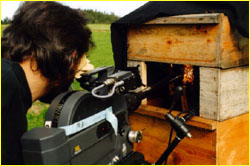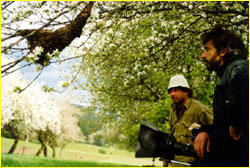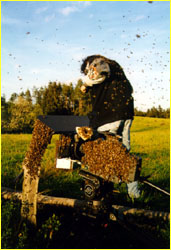
|
 |
|
Part 2 | Back to Part 1 We prepared everything, including lighting the 16-square-inch set and fixing it so that the lens formed one of the hexagonal cell walls. Then Peter Hopfgartner, our star beekeeper in the film, thought of a trick. He prevented a fully developed queen from laying eggs by isolating her in a small cage. That way, her urge to lay eggs became so strong that the queen forgot all about light, camera, and people. All she had to do was find a cell and lay the egg, and the shot was done. This scene took probably two hours. The hardest and longest task was building the sets and setting up the lighting. The filming itself had to be done very fast, because the bees were patient with us for no more than two minutes. Either they buzzed away or fled into a corner, or everything dissolved into chaos. To get all these shots inside the hive, I had to know bee behavior very well. Without my friend Peter, who has studied and observed bees since he was five years old, this film could not have been realized. NOVA: How long was the film in the making?
NOVA: How did you get interested in beekeeping? Thaler: My grandfather had a little bee hut, and he harvested excellent forest honey. When he died, my father took over that hut. Unfortunately, he didn't have my grandfather's talent, and soon the bees weren't doing too well. The honey harvests were poor, and I decided to take over the bee hut. By the time I was 19, I had 30 bee populations. Most of it I learned from my friend Peter. NOVA: Did you wear complete beekeeping gear while you were filming? Thaler: No, I didn't wear a protection suit for the shoots, because the outfit hindered me too much in my work. Of course, I got stung, but a beekeeper is used to that anyway. Sometimes it happened that we had to stop the shoot because the bees became too aggressive. The aggressiveness of bees depends. If there is enough nectar and they have plenty to eat, they are relatively peaceful and don't sting. But when the weather turns bad or when an unpleasant wind blows, they sting more.
Bees are very sensitive to smell. If you smell like alcohol, sweat, or bad aftershave, they sting immediately! When we did the scene with the dandelion, I got stung very often, and a few times I had to flee. I was puzzled. Then I noticed that co-director Herbert Habersack was particularly smoothly shaved that morning. I went over to him and sniffed his skin, and the scent of strong, manly, musky aftershave greeted me. Habersack spent the rest of the day 500 feet away from me under an apple tree, and the bees were peaceful.
Continue: Special viewing platforms The Making of | Anatomy of a Hive The Buzz About Bees | Dances With Bees Resources | Transcript | Site Map | Tales from the Hive Home Editor's Picks | Previous Sites | Join Us/E-mail | TV/Web Schedule About NOVA | Teachers | Site Map | Shop | Jobs | Search | To print PBS Online | NOVA Online | WGBH © | Updated October 2000 |
 To gain access to the inside of a bees nest and film
the behaviors within, Thaler's crew constructed a
special outdoor artificial hive.
To gain access to the inside of a bees nest and film
the behaviors within, Thaler's crew constructed a
special outdoor artificial hive.
 Thaler (right) and beekeeper Peter Hopfgartner wait
for a swarm to move on.
Thaler (right) and beekeeper Peter Hopfgartner wait
for a swarm to move on.
 Thaler flees as a swarm suddenly alights on his movie
camera.
Thaler flees as a swarm suddenly alights on his movie
camera.